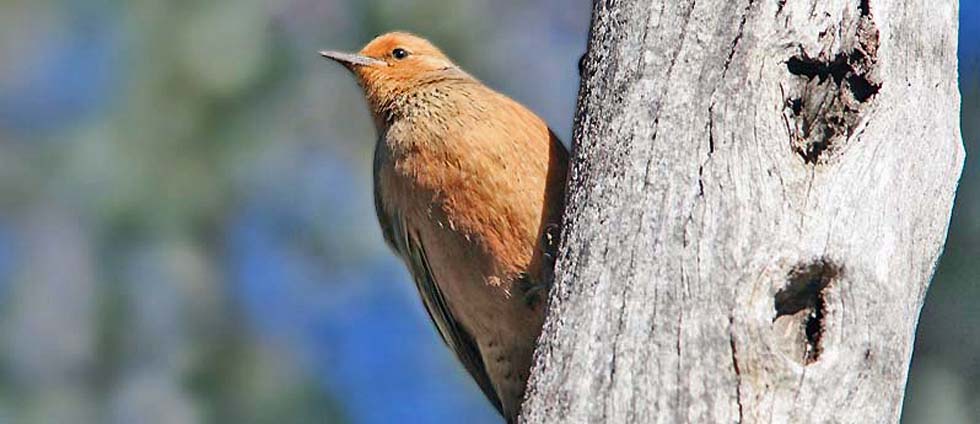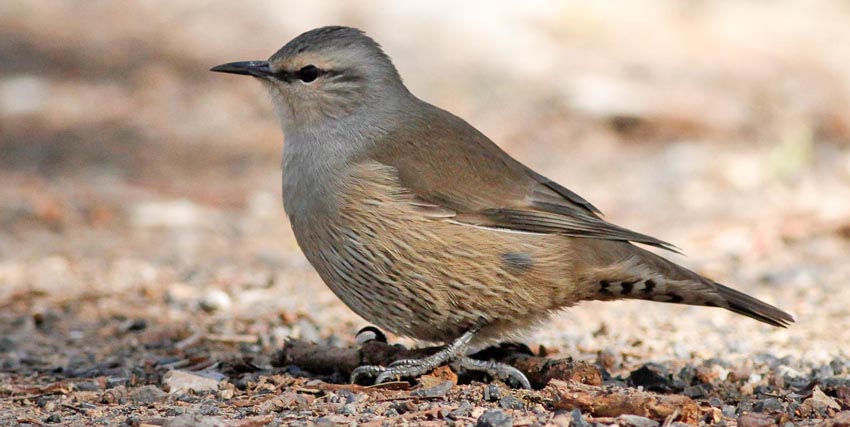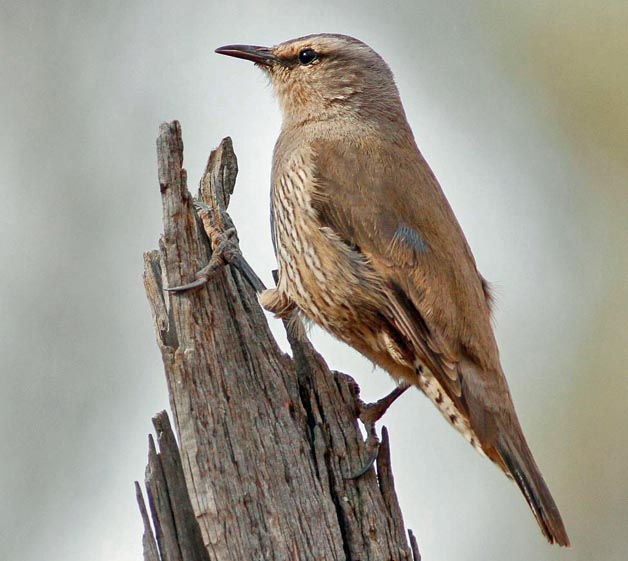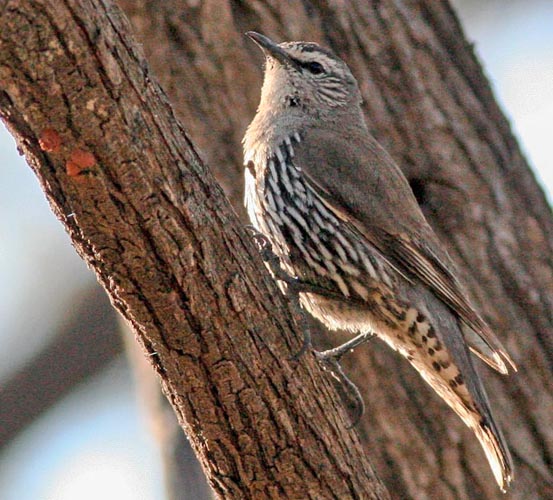
a web page by Don Roberson |
AUSTRALASIAN TREECREEPERS Climacteridae |
|
At least four of the five species of Climacteris are communal breeders: Brown, Rufous, Black-tailed C. melanura, and Red-browed C. erythrops. In Rufous Treecreeper (below) groups of up to 6 birds consist of a breeding pair, their male and (rarely) female offspring from the prior year, and sometimes even non-breeding birds from adjacent territories, all of which aid in feeding the incubating female and the nestlings (Noske 1980, 2007). |
 |
Nests of grass, feathers, and mammal fur are concealed in hollows of stumps and trees. A problem faced by all Australian Treecreepers is that they require a hole in which to nest, but there are no woodpeckers in Australasia to make holes. Tree hollows only develop with microbial and termite action, which can take a hundred years to create a suitable cavity. Such cavities are at a premium, and are both staunchly defended and used in successive years. Artificial cavities are sometimes used — "ventilation pipes, chimneys, hollow fence posts, nestboxes, and even, on occasion, an old kettle!" (Noske 2007). Treecreepers forage on the trunks and branches as the bird ascends using only its feet (they do not use their tail as a prop, as do Holarctic treecreepers or woodpeckers). Insects are taken from bark crevices. Brown Treecreeper (below, another nice Murray Lord photo) spends a lot of time on the ground, and ants are a primary prey. In stomach content studies from NE New South Wales, ants and their larvae represented up to 95% of the items found. |
 |
Because of their behavior, many early taxonomies placed the Climacteridae near the Holarctic treecreepers, the Spotted Creeper (Salpornis) of Africa and India, and the Philippine creepers (Rhabdornis). It is now known that they are not related to any of these birds; their tree-climbing behavior is an example of convergent evolution. Their "non-relationship" with other "creepers" globally was not sorted out until the 1960s, and their true taxonomic position not until the 1980s. Australian Treecreepers have a distinctive syndactylous foot structure, in which the "anterior digits 2 and 3 are bound together by a membrane to the end of the 1st phalanx on digit 2, and digits 3 and 4 are joined to the base of the 3rd phalanx on digit. This condition of the foretoes apparently allows them to act in concert with the hallux as the bird creeps on trunks and branches" (Sibley et al. 1984). It is clear that Australasian Treecreepers are part of the great Australasian radiation, but their exact position is still unclear (Noske 2007). The initial DNA-DNA hybridization data suggested that they were most closely related to lyrebirds, scrub-birds, and bowerbirds (Sibley & Ahlquist 1990). |
Photos: Murray Lord photographed the top Brown Treecreeper Climacteris picumnus (nominate picumnus) Brown Treecreeper in Gluepot Reserve, South Australia, in October 2012, and the bottom (race victoriae) in the Capertee Valley, New South Wales, Australia, in June 2011. The Rufous Treecreeper C. rufa was photographed in the Dryandra Forest, Western Australia, in Aug 2008. Murray Lord photographed the White-browed Treecreeper C. affinis near Bowra Station, Queensland, in Sep 2010. Bibliographic note: there is no "family book" covering the Climacteridae, but the family is very well covered, with text and photos, in Noske (2007). Literature cited:
|
 Australasian
Treecreepers are a small family composed of 7 species in two genera.
One species inhabits the mountains of New Guinea (Papuan Treecreeper Cormobates placens)
and the rest are restricted to Australia. As the name suggests, this
group fills the "creeper" niche in Australasia, working up the main
trunks and branches of Australian woodlands. Brown Treecreeper
(left in a picturesque pose by Murray Lord) prefers eucalyptus groves
but is found in a wide variety of open woodlands in eastern and
southeastern Australia. It often feeds on fallen branches and logs,
bobbing its tail when resting. It, like the rest of the Australia
species, has a broad orange wingstripe seen in flight.
Australasian
Treecreepers are a small family composed of 7 species in two genera.
One species inhabits the mountains of New Guinea (Papuan Treecreeper Cormobates placens)
and the rest are restricted to Australia. As the name suggests, this
group fills the "creeper" niche in Australasia, working up the main
trunks and branches of Australian woodlands. Brown Treecreeper
(left in a picturesque pose by Murray Lord) prefers eucalyptus groves
but is found in a wide variety of open woodlands in eastern and
southeastern Australia. It often feeds on fallen branches and logs,
bobbing its tail when resting. It, like the rest of the Australia
species, has a broad orange wingstripe seen in flight.  White-browed Treecreeper (right, in another shot by Murray Lord) is perhaps the least known member of genus Climacteris.
White-browed Treecreeper (right, in another shot by Murray Lord) is perhaps the least known member of genus Climacteris.